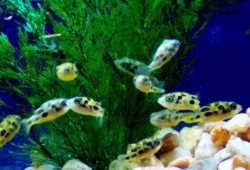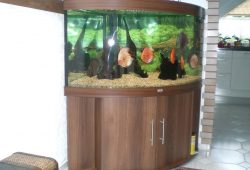Nutrition for Marine Life in the Coral Aquarium
In the article I’m going to tell you about Nutrition for Marine Life in the Coral Aquarium. Feeding every life form in a coral reef tank requires more than fish pellets or flakes. Here’s a few tips for maintaining a thriving marine environment.

Sure, throwing commercial fish pellets or flakes into your reef tank a few times a week might keep your fish alive, but what about the corals, anemones, and bivalves in the aquarium that also need proper nutrition? There are many different foods and techniques for feeding reef tanks, and the savvy reefkeeper will want to research their particular tank’s inhabitants to create their tank’s ideal diet. Here are some ideas for foods that should go into a reef tank.
Contents
What to Feed Fish
This is the easy part to figure out, as most aquarium-friendly fish will take or reject the food offered them in full view of the reefkeeper. Generally, a variety of live or frozen mysids, krill, and brine, as well as occasional high-quality, commercial pellets or flakes, should insure well-fed fish. For larger-mouthed fish, chopped shrimp, clams, baitfish or squid is readily accepted. Seaweed supplements can be added for herbivores.
Opinions on how often to feed reef fish vary from once a week to three times daily. In general, small amounts more often seems to work better than large amounts less often. Watch your water quality: if there is more leftover food than your cleaning crew of snails, crabs, and echinoderms can handle, or you find your nitrates and nitrites on the rise despite a working skimmer and small, frequent water changes–then you are overfeeding!
What to Feed Corals, Sponges, Fan Worms and Tunicates
Though proper lighting will ensure that your corals get some food via photosynthesis, it should not be the corals’ only source of food. There are many commercially available “marine snow” formulas for filter-feeding invertebrates. Generally, they consist of a combination of zooplankton, phytoplankton, trace elements, and particulate and dissolved organic material designed to replicate natural marine snow.
It is best to turn off protein skimmers and filtration for a half an hour when feeding marine snow. Target-feeding corals, sponges, etc. with this thick, liquid food can easily be accomplished with a syringe or turkey baster. Many corals feed at night, so evening feeds are often more productive. Follow the manufacturer’s directions for best results.
Live or frozen rotifers are also readily available in most pet stores and are accepted by many corals. Rotifers can also feed very small fish or fry. Some tentacled corals have been known to feed on larger prey, such as brine, krill, or mysids.
Food that is too large or in too great an amount can cause corals to regurgitate, which may cause a deterioration in water quality.
What to Feed Bivalves
These difficult-to-keep reef inhabitants should be target-fed with a syringe or turkey baster. A combination of marine snow with one of the fatty-rich, microalgae-filled liquid foods offered on the market as a “larval food” seems to be a fairly successful approach to feeding clams, scallops, and oysters. Giant clams (Tridacna) get much of their nutrition through photosynthesis, so adequate lighting is especially important for these bivalves
What to Feed Anemones
Anemones are easily fed with brine, mysids, krill, or, for larger specimens, chopped shrimp, squid, or fish. They may also benefit from marine snow.
The responsible aquarist will want to thoroughly research the particular fish, corals, etc. which inhabit their reef tank in order to create a diet that is most palatable and natural to them. Unfortunately, there is no single food that will satisfy all the creatures in any aquarium, so finding the right combination of the right foods takes time, research, and attention to detail.



